
Luca Giordano was an Italian late-Baroque painter and printmaker in etching. Fluent and decorative, he worked successfully in Naples and Rome, Florence, and Venice, before spending a decade in Spain.
Aniello Falcone was an Italian Baroque painter, active in Naples and noted for his painted depictions of battle scenes. Some sources refer to him as Ancillo Falcone.

Guido Reni was an Italian painter of the Baroque period, although his works showed a classical manner, similar to Simon Vouet, Nicolas Poussin, and Philippe de Champaigne. He painted primarily religious works, but also mythological and allegorical subjects. Active in Rome, Naples, and his native Bologna, he became the dominant figure in the Bolognese School that emerged under the influence of the Carracci.

Salvator Rosa is best known today as an Italian Baroque painter, whose romanticized landscapes and history paintings, often set in dark and untamed nature, exerted considerable influence from the 17th century into the early 19th century. In his lifetime he was among the most famous painters, known for his flamboyant personality, and regarded as an accomplished poet, satirist, actor, musician, and printmaker, as well. He was active in Naples, Rome, and Florence, where on occasion he was compelled to move between cities, as his caustic satire earned him enemies in the artistic and intellectual circles of the day.
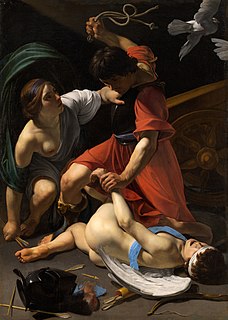
The Caravaggisti were stylistic followers of the late 16th-century Italian Baroque painter Caravaggio. His influence on the new Baroque style that eventually emerged from Mannerism was profound. Caravaggio never established a workshop as most other painters did, and thus had no school to spread his techniques. Nor did he ever set out his underlying philosophical approach to art, the psychological realism which can only be deduced from his surviving work. But it can be seen directly or indirectly in the work of Rubens, Jusepe de Ribera, Bernini, and Rembrandt. Famous while he lived, Caravaggio himself was forgotten almost immediately after his death. Many of his paintings were reascribed to his followers, such as The Taking of Christ, which was attributed to the Dutch painter Gerrit van Honthorst until 1990. It was only in the 20th century that his importance to the development of Western art was rediscovered. In the 1920s Roberto Longhi once more placed him in the European tradition: "Ribera, Vermeer, La Tour and Rembrandt could never have existed without him. And the art of Delacroix, Courbet and Manet would have been utterly different". The influential Bernard Berenson stated: "With the exception of Michelangelo, no other Italian painter exercised so great an influence."

Jusepe de Ribera was a Spanish Tenebrist painter and printmaker, also known as José de Ribera and Josep de Ribera. He also was called Lo Spagnoletto by his contemporaries and early writers. Ribera was a leading painter of the Spanish school, although his mature work was all done in Italy.

Vincenzo Camuccini was an Italian painter of Neoclassic histories and religious paintings. He was considered the premier academic painter of his time in Rome.
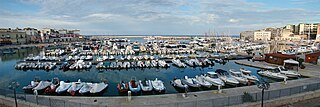
Bisceglie is a city and municipality on the Adriatic Sea of 55,251 inhabitants in the province of Barletta-Andria-Trani, in the Apulia region, in southern Italy. The city was awarded Blue Flag Beach certification in 2001 for high environmental and quality standards. Scallette and Salsello Beaches were also certified in 2003, 2005 and 2006.
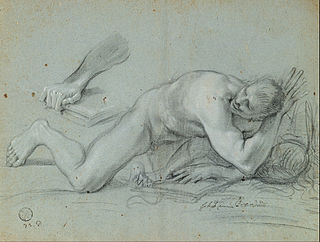
Giovanni Angelo Canini (1609–1666) was an Italian painter and engraver of the Baroque period.

Francesco Vanni was an Italian painter, draughtsman, printmaker, publisher and printer active in Rome and his native city of Siena.

Giovanni Battista Caracciolo (1578–1635) was an Italian artist and important Neapolitan follower of Caravaggio. He was a member of the murderous Cabal of Naples, with Belisario Corenzio and Giambattista Caracciolo, who were rumoured to have poisoned and disappeared their competition for painting contracts.
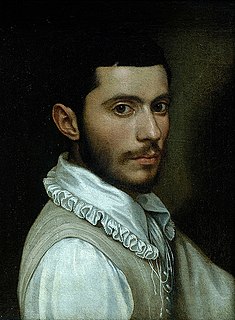
Scipione Pulzone, also known as Il Gaetano, was a Neapolitan painter of the late Italian Renaissance. His work differs in several respects from the Mannerist style predominant at the time. He was active mainly in Rome, but also worked in Naples and Florence. It is thought that he studied under Jacopino del Conte in Rome.

Massimo Stanzione was an Italian Baroque painter, mainly active in Naples, where he and his rival Jusepe de Ribera dominated the painting scene for several decades. Most of his work, in both oils and fresco, depicted religious subjects. A papal knight, he is often referred to as Cavalliere Massimo Stanzione, especially in older sources.

Paolo Domenico Finoglia, or Finoglio, was an Italian painter of the early-Baroque period, active mainly in South Italy, including Naples and towns in Apulia.
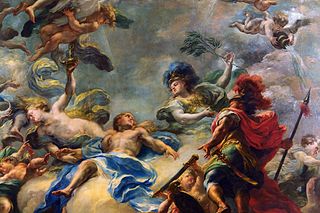
Giacomo del Pò, also spelled del Po, was an Italian painter of the Baroque. He was born in Palermo, the son of Pietro del Pò who was also his teacher.
Giovanni Alberti was an Italian painter, known for his perspective painting (quadratura). He was also a poet and writer about art critic.
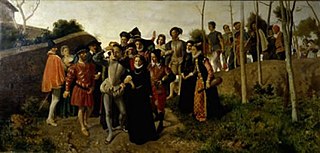
Bernardo Celentano was an Italian painter of the 19th century, who painted historical themes in the style of Realism.
Cesare and Vincenzo Conti, two brothers, were natives of Ancona, but went to Rome during the Pontificate of Gregory XIII, by whom they were employed. They were also both employed by his successors, Sixtus V, Clement VIII, and Paul V. Cesare was esteemed for his grotesque ornaments, and Vincenzo painted the figures. Cesare died at Macerata about 1615. Vincenzo went on to the court of Savoy, and died there in 1610. Some of their works are in Santa Maria in Trastevere, while in San Spirito in Sassia is the history of San Giacomo del Zucchi, and in Santa Cecilia, 'St. Agnes,' and the 'Martyrdom of St. Urban.'

Francesco Fracanzano (1612–1656) was an Italian painter who participated in the Masaniello rebellion.

Cesare Fracassini was an Italian painter, mainly of large mythologic or religious topics.
























